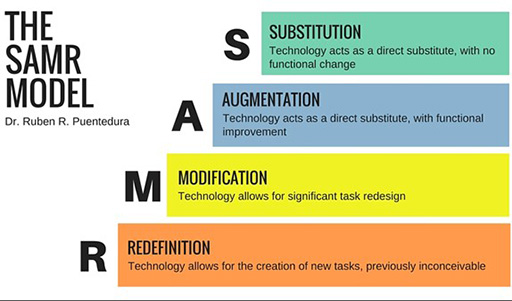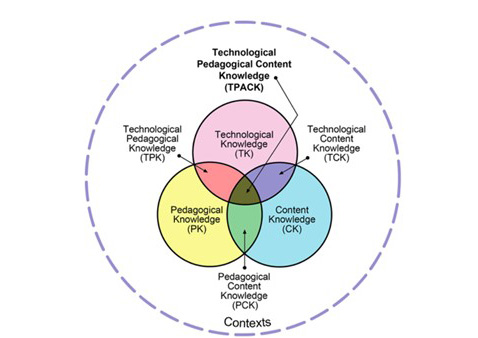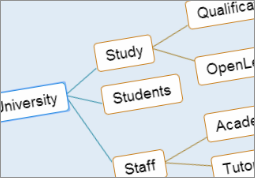2 Practice, preferences and opportunities
One of the biggest mistakes teachers can make when they move towards technology supported learning is the assumption that traditional content and approaches can be used unchanged. In most cases, they can’t. If you simply reuse content that has been tried and tested in traditional modes of teaching, you will discover that in a digital environment, it is inadequate. This is because teaching online is an entirely new approach to teaching face-to-face (Puentedura, 2018). Technology supported learning demands a new kind of approach. It also requires appropriate and effective integration of technology into that pedagogy.
Face-to-face teaching has a long history of tradition on which it draws, in order to facilitate the establishment of a channel of communication, for example: bells ring, the teacher clears her throat or shouts, "Oy, you! in the back. Yes, you! Are we quite ready? Thank you!" The chairs in the room are oriented in a certain way to reinforce certain channels and dampen others: theatre style, open U, boardroom table. There may be communication aids: interactive white boards. Similarly, the establishment of relationships is facilitated by years of tradition and mediated by the channels of communication. We draw on a deep tradition of knowledge, much of which is tacit. This tacit knowledge of face-to-face learning interactions might need some re-conceptualisation when we move into the online world. As Robin Mason (2001) said, often the first time we question the meaning and form of teaching at all is when we try to adopt new learning technologies.
There are several useful models of technology integration. One example is the SAMR model (see the illustration below), which was devised by American educator Ruben Puentedura (2018). The model categorises technology use into four levels. At the most basic level, introducing new technology is simply a Substitute for a previous method. Using an interactive white board purely for projection of slides would fall into this category. At the most advanced level, Redefinition happens when a technology opens up new and previously unobtainable areas of pedagogy. The two (top) levels are classed as enhancement, while (Modification and Redefinition levels can be considered transformational.
Think about the technologies teachers currently use, or plan to use in the classroom, and imagine how each of the levels could describe their integration into teaching and learning activities. Are you merely substituting, or are you delving deeper?
Teachers will apply the above model according to their personal philosophies of pedagogy. If they prefer a more didactic (instructional) approach, they may wish to ensure that the technology at their disposal is under their control, there to support their teaching. If they teach in a facilitative (pupil centred) style, they may decide that the technology should be in the hands of the pupils, to support their learning. In reality, most teachers oscillate between the two approaches, depending on the lesson, the subject matter, the level of their pupils' understanding, and other variables. Read the box below, written by a teacher, and think about how this applies to teaching in your school.
In my teaching, I can think of numerous contexts where the above model can be applied. For example, each and every level of the SAMR model of technology integration might be witnessed in my teaching sessions within a single hour!
Progressing from simple to complex for example, may require different applications of technology to support both teaching and learning. I might move from a didactic style of introduction through more participative elements, and finally to a completely pupil-centred activity, where the technology progresses from substitute to redefinition depending on the mode of pedagogy. On occasions, where my sessions predominantly feature pupil activities, I'm there purely as a support or facilitator if they get into difficulties. In such contexts, technology is driven by the pupils rather than the teacher. This is very similar to an earlier model by John Heron, in which teachers move from facilitative mode, through to didactic and autonomous mode within a single session. (Heron, 1972).
Another useful model of technology integration is called TPACK and is attributed to Mishra and Koehler (see the diagram below). It focuses more upon the knowledge and skills teachers require to successfully adopt a technology supported or online approach to education. Mishra and Koehler (2006) believe that viewing various teacher knowledge domains as separate from each other is a mistake. They prefer to see three integrated sets of knowledge - pedagogical (teaching), content (subject expertise) and technological (use of technology in education) as overlapping and influencing each other. The assumption is that educators who are capable of understanding the overlaps between the domains will have a broader, and perhaps more flexible expertise than those who are solely subject experts, technology specialists or traditional teachers.
No technology can replace good, empathetic teaching and the warmth of personal interaction, but technology can enhance and extend these if integrated appropriately.
Both SAMR and TPACK can be applied to make better sense of how we embed technologies into the processes of teaching and learning.
Activity 2
How does your school use technology in the classroom? Do teachers primarily use it to support pupils or to augment their own teaching? Reflect on the impact of COVID-19 on the use of technology. In many schools the IT strategy took a huge jolt through COVID-19. After returning to school after pandemic lockdowns, you may have seen a bit of a ‘bounce back’ with teachers enjoying being back in the classroom and many have become significantly more skillful in the use of ICT – the opportunities are significant! Create a mind map of the possible uses of technology in your school. Some, you might have already used, but also try to include some that you may not have used yet.



